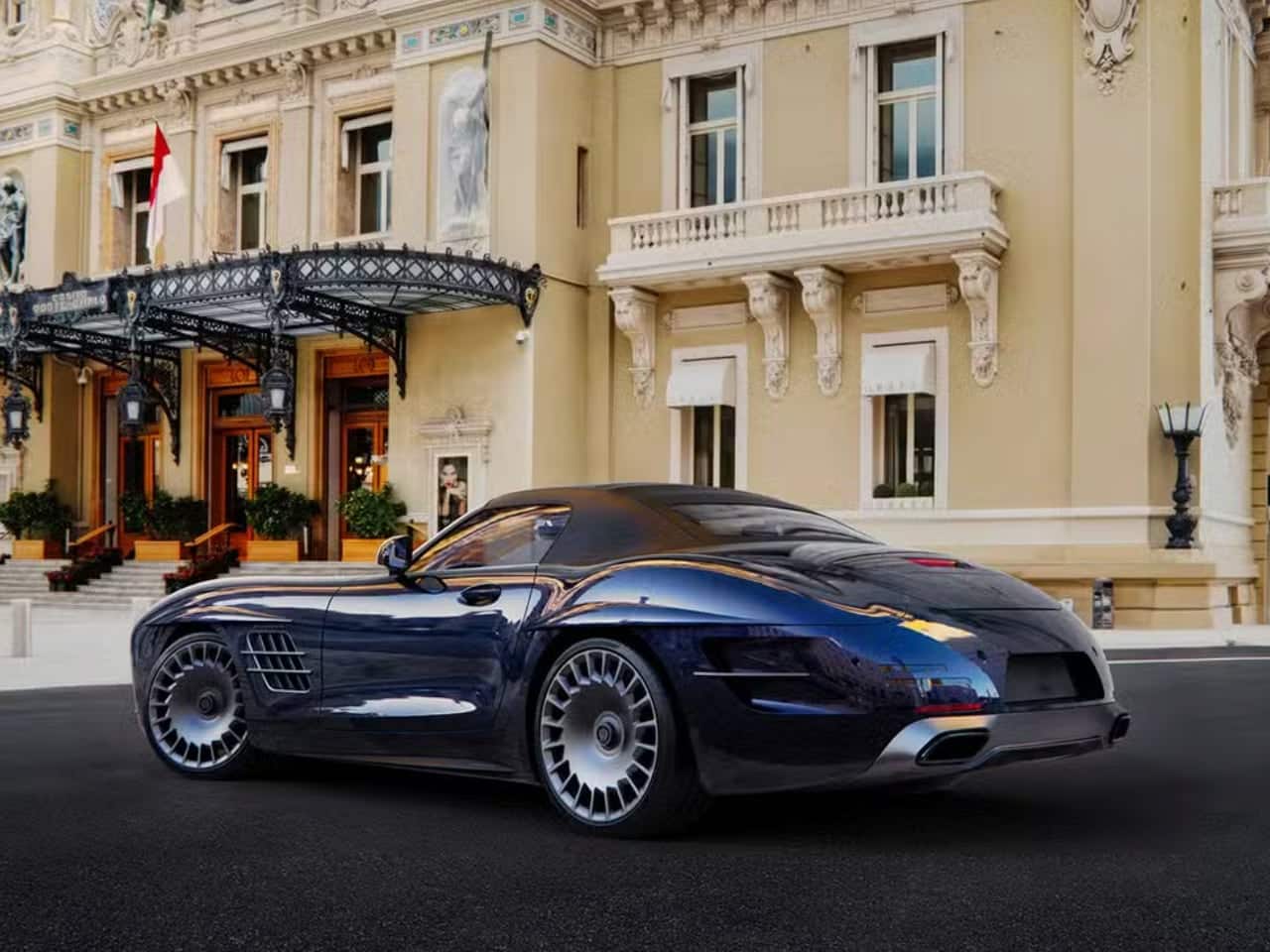Meticulous Craftsmanship: Thousands of Hours Invested in a Single Car
Nearly four thousand hours of human labor are invested in each Saoutchik Torpedo S vehicle. To put this into perspective, this amount of time exceeds what most people spend working over two full years. The focus here is not merely on building a car, but on transforming a modern Mercedes-AMG GT Coupe into a piece of art reminiscent of what was produced in 1955—yet infused with a contemporary spirit belonging to 2025.
A Historical Comeback After Decades of Silence
The company’s history itself is fascinating; it was founded back in 1906, and its founder, Jacques Saoutchik, created some of the most iconic car body designs still revered today. However, he passed away in 1955, and the company disappeared with him. After more than seven decades of silence, the brand has been revived in the Netherlands, supported by a team dedicated to preserving the original visionary spirit while leveraging modern manufacturing tools and techniques.
Why Does Production Take So Long?
Work on these cars does not rely on mass production or automated manufacturing. Instead, it is a meticulous manual process measured down to the millimeter, where carbon fiber parts are shaped and adjusted with extreme precision, making each car unique and distinguished in its details. Production is extremely limited, not exceeding 15 cars, reflecting the scale of craftsmanship and the attention devoted to every single piece.

The Numbers Behind the Saoutchik Torpedo S: A Symbol of Meticulous Craftsmanship
The figures related to the Torpedo S demonstrate an exceptional level of craftsmanship and attention to detail. Producing only fifteen cars requires more than 4,000 hours of manual labor per vehicle, amounting to a total of 60,000 hours of human effort across the entire production line. This is roughly equivalent to 30 years of work by a single person.
Carbon Fiber Body: Precision Down to the Millimeter
The entire car body is made from carbon fiber, replacing every original panel on the AMG GT. This body is shaped with high precision by artisans who work to the millimeter, not the minute, emphasizing that this process is far from mass production—it’s a living sculpture on wheels.
Original Engine and Emotional Value in Design
Despite the comprehensive design modifications, the original AMG GT twin-turbo 4.0-liter V8 engine remains unchanged, preserving the power and speed established by Mercedes. However, the car’s focus is not on technical specifications but on proving that proportions and surface design carry genuine emotional value.
The 22-inch chrome wheels enhance the car’s elongated lines, while the round headlights and restrained grille hark back to an era when elegance stemmed from design rather than marketing. In this context, designer Ogur Sahin wraps this classical language in a modern heart, steering clear of fake or vulgar styles, resulting in a look that is both authentic and refreshed—untethered to any specific decade.
Design: Evoking Memory Beyond Imitation
Upon closer inspection, the car reveals a fundamental difference. This is not just a traditional or retro redesign but a revival of the design logic of a certain era through physical proportions and the thoughtful use of materials. The body lines do not literally imitate the past but reinterpret it in a contemporary style.
The rear bulges expand with deliberate dramatic tension, without causing visual chaos or confusion. There are no random folds or excessive finishes—each panel appears to have been cast with high fluidity, featuring curves that reflect light like a carefully polished grand piano displayed at beauty contests.

From Sharpness to Restraint in the Torpedo S Design
The original Mercedes-AMG GT Coupe did not possess this level of restraint and balance in design. Its original metal panels featured sharp creases, distinct technical intakes, and explicit performance cues that reflected the car’s aggressive sporty character. Yet, all these elements have vanished in the new Torpedo S design.
Use of Carbon Fiber: A New Design Language
Instead, the Torpedo S wraps its mechanical base in long, clean waves of carbon fiber, giving the car a smoother, more fluid appearance. On the front end, the design abandons the usual aggressive AMG badge features, replacing them with a calm horizontal grille surrounded by classic round headlights that could easily belong to a 1954 roadster. Here, the design pays respect to the past without falling into exaggeration or caricature.
Side Details: Between Structure and Simplicity
On the sides, the gill-like ventilation openings on the front fenders clearly salute the details of the famous 300 SL, but these vents are set deeper into the surface, making them appear as part of the structure rather than mere superficial decoration.
This interpretation of details does not feel ornamental; it reflects a philosophy of coherent structural design. The precise integration of thin chrome strips further sets a harmonious visual rhythm across the sides, breaking the bulk of the massive car without complicating the design language or distracting the eye.
Purity of Design: Avoiding Visual Clutter
Also notable is the absence of logo clutter and artificial vents used solely for decoration. The design here is based on continuous, smooth sculpting that transitions delicately and elegantly from surface to shadow, reminiscent of the quality of traditional handcraftsmanship. This grants the car a distinctive identity that blends modernity with classic memories.

Wheel Design and Rear Profile: Quiet Strength and Refined Flow
Moving to the wheels, we find monoblock turbine-style discs with a polished finish that almost entirely covers the wheel gaps. These wheels are large and bold in size, yet executed with moderation—there are no contrasting colors such as glossy black accents or two-tone designs that might distract the eye.
Instead, the wheels focus clearly on performing one function: asserting a strong visual presence at the car’s corners. This effect is achieved through a skillful combination of size and depth, making the wheels a fundamental element in the design language without unnecessary complexity.
From the rear, the car’s cover smoothly curves to form an elongated rear profile, pierced by taillights that nearly blend into the surface line without protruding excessively. The result is a low, wide, and calm vehicle, where tranquility is no longer just a design choice but a consciously and carefully crafted element.

Torpedo S Interior: Harmony Between Heritage and Contemporary Precision
Inside the cabin, the design narrative flows smoothly. While the Torpedo S retains the original Mercedes cockpit architecture, the reupholstery in light blue and polished aluminum brings a color transformation that moves away from the usual formal or sterile feel.
The air vents become decorative elements adding a touch of elegance, while the controls resemble finely crafted jewelry pieces, reflecting a distinctive blend of luxury and craftsmanship.
This fusion of old-world spirit and modern precision is highlighted in the center console, which expands with precise symmetry, adding a sense of balance and harmony. Even the steering wheel is carefully treated, featuring a simple emblem and two-tone leather, centered by a translucent Saoutchik logo, shifting the perception from a high-tech performance tool to a steering wheel with a classic, authentic character.

The Quiet Design: The Art of Suggestion Without Noise
What distinguishes the Torpedo S design is its lack of need to shout for attention. The design does not seek to promote itself with exaggerated gestures or flashy extras; instead, it chooses a quieter path, inviting the viewer to contemplate and examine the details carefully.
The closer you get, the more the car reveals new layers of taste and craftsmanship — from the smooth flow of the roofline that seamlessly connects with the rear trunk when the hardtop is raised, to the removal of all excessive air vents and rear diffusers on the back, replaced by clean, graduated curves that enhance the sense of balance and simplicity.
Even the exhaust outlets are wide but balanced, integrated skillfully without any exaggeration or attempt to attract attention, reflecting the spirit of refined design that values elegance within the bounds of visual silence.

Saoutchik Torpedo S: A Masterpiece Beyond Performance
The Saoutchik Torpedo S commands you to stop and reflect, far beyond the noise of specification sheets and traditional performance numbers. This car is not merely a means of transportation or a speed machine; it is a moving work of art embodying craftsmanship and uniqueness in the automotive world.
The Torpedo S does not need to justify its existence or prove anything to anyone — it knows its identity and value perfectly. It is a masterpiece crafted by skilled hands, carrying the spirit of high craftsmanship and meticulous design, with the engine serving solely as the mechanical element accompanying this unique work of art.







